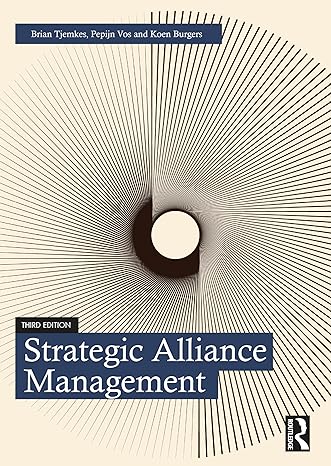Since the industrial era, companies that have had the best assets have usually been the most competitive.
Question:
Since the industrial era, companies that have had the best assets have usually been the most competitive. However, this situation has changed over the last decade. In today’s competitive environment, companies are constantly looking for new sources of customer value.
Organizations are often unable to generate this value on their own and therefore have to rely on an ecosystem of organizations that helps and supports them in fnding this new value. The ability to collaborate with an increasing number of varying stakeholders, which are more and more loosely connected to the company, is essential in meeting ever-changing customer demands. This is especially true in the hi-tech industry, but it is notable how two giants are choosing very different strategies.
Apple Computer Inc. (Apple) was founded in 1976 by Steven Jobs and Steve Wozniak. For almost three decades, Apple focused on the design and manufacturing of personal computers, including revolutionary models like the Apple II, which institutionalized the home computer market; the Macintosh, which revolutionized the DTP market; and the Power Mac. In the mid-
1990s, Apple was struggling because of an ill-controlled product portfolio that enabled other hardware manufacturers to use Apple Operating Systems, products that were too expensive and competition that was not sitting still. The introduction of Microsoft’s Windows95 further reduced Apple’s competitive advantage. In 1997, Apple bought NeXT, the company Steve Jobs had founded in 1985 after he was forced to leave Apple. Steve Jobs regained control of Apple and ended the possibility of Apple clones; Apple itself introduced the translucent plastic iMac in 1998. This marked the turnaround of the company. In 2001, Apple introduced iTunes and the iPod. With iTunes, Apple created a media management system that acted as a front layer for devices that were introduced in the following months and years. In 2001, Apple shocked the world with the introduction of the frst iPod. Through the iPod, users could listen to music and later also videos using a cleverly designed device. In 2007, Apple introduced the iPhone, which revolutionized the smart-phone industry. The year 2010 saw the release of the iPad, which basically defned the tablet market. Apple knew that it required an ecosystem approach to differentiate itself from a traditional appliance manufacturer.
With the introduction of the iPhone in 2007, Apple allowed third-party software developers to develop software for Apple devices. Third-party developers could download a software development kit for free to develop applications for the iPod and iPhone and later the iPad. Publishing the applications in the App Store is only possible after paying an Apple Developer Connection membership fee; then the apps go ‘on sale’ in the App Store. The software developer is free to set a price for the app, but Apple receives a 30 per cent fee.
The App Store was launched in 2008, which fuelled the success of the iPhone and iPod. The App Store set the standard in the smart-phone market, which has been followed by Google’s Play Store and Microsoft’s Windows App store. In the business ecosystem that Apple has created, Apple is the dominant player. It holds frm control over its ecosystem. For one thing, Apple has to frst sell its devices, with high margins, before publishers in the App Store can sell their products. This latency in earning models requires publishers to be fully dependent on the ability of Apple to develop and market an attractive platform. Next, Apple has the fnal authority to decide what it will and will not publish on the App Store. In 2022, Apple and Mercedes-Benz announced that Apple Music’s highly acclaimed Spatial Audio with support for Dolby Atmos is now available as a native experience in Mercedes-Benz vehicles for the frst time, delivering on a shared commitment to provide customers worldwide with the very best music experience. Also in 2022, Apple accelerated its work with suppliers to 318 Business ecosystems decarbonize Apple-related production and expand investments in clean energy and climate solutions around the world. Apple requires from their suppliers to report on progress towards these goals—specifcally Scope 1 and Scope 2 emissions reductions—and will track and audit annual progress. Apple also encourages suppliers to address the greenhouse gas emissions beyond their Apple production, prioritizing clean energy.
Questions 1 Applying a business ecosystem lens, provide a systematic comparison of Apple’s and Amazon’s ecosystems. Explain why both ecosystems are successful.
2 Taking the viewpoint of developers, explain why they would participate in either the Apple and/or Amazon business ecosystem.
3 Identify the future hazards and adversities that are most likely to undermine the success of both business ecosystems.
Step by Step Answer:

Strategic Alliance Management
ISBN: 978-1032119250
3rd Edition
Authors: Brian Tjemkes ,Pepijn Vos ,Koen Burgers






